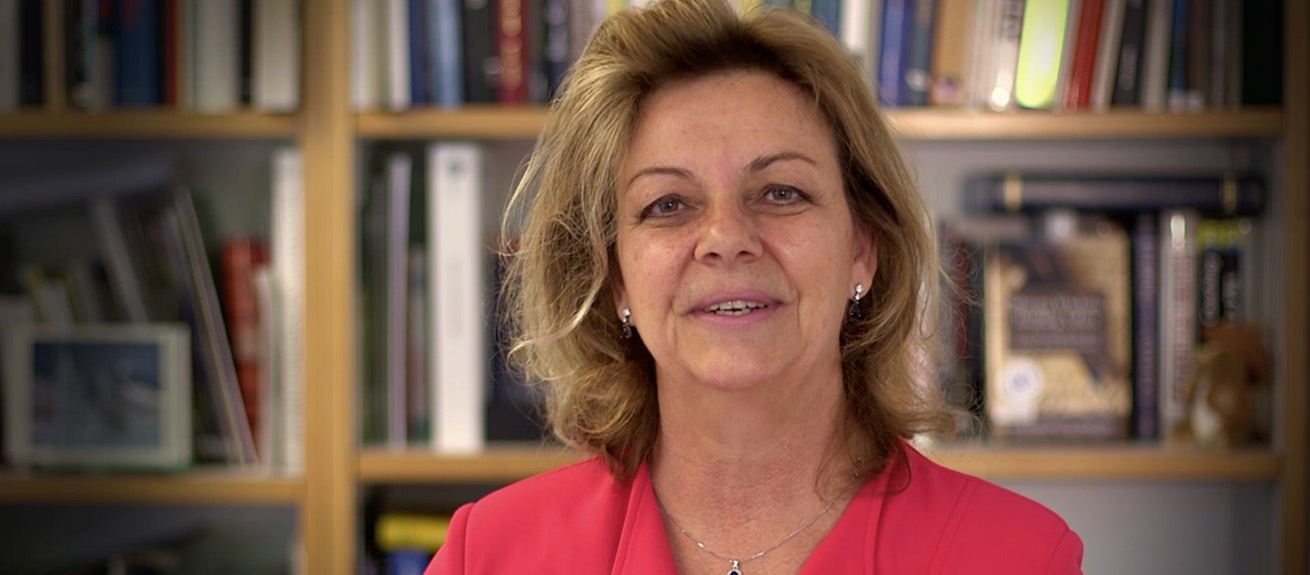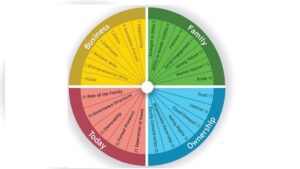
Dino Frescobaldi, a poet of the late 13th/early 14th century, played an important role in the development of Italian literature by salvaging the first seven cantos of Dante’s Divine Comedy when the more famous poet was forced to flee Florence for political reasons. This was not Frescobaldi’s only legacy: He was also a member of a successful Tuscan merchant family that began producing wine around that time. Some 700 years and 30 generations later, the family is still running a thriving wine production business and continues to expand and innovate (see Case 1).
Case 1: Frescobaldi
There is a direct inheritance from Tuscan merchants of the middle ages to the modern Frescobaldi international company. For 700 years and 30 generations, wine production has been at the heart of the business. It was commited to sustainable agriculture even before environmental concerns became fashionable; when you are managing with the needs of future generations in mind, this comes naturally. In the 29th generation, ownership and leadership were extended from the first-born son to a highly talented sibling group. Opening up ownership and leadership in this way has supported expansion in the regions the company supplies to cover more than 60 countries, and it has successfully diversified into restaurants and wine bars. In 2014 it entered the tourism industry, offering tourist accommodation in some of its outstanding properties in the family’s Tuscan heartland, in the village of Pomino, close to the family’s Nipozzano castle.
The family is always looking to innovate. Marchese Dino Frescobaldi, of the 29th generation, warned against complacency: “Our family business has had notable success. But nothing could be more wrong than to think that the main and final choices have now been made and that the problems have been resolved once and for all. Other choices and other decisions await us.”6
Only a small minority of highly successful business-owning families have exceled and thrived through several generations, including Miele, Follett, Takanashi (see Case 2) and Henkel. A high proportion of family firms struggle to survive to the second and third generations,1 and articles often comment on the risks associated with family firms. This statistic is misleading and biased, however. The lifespan of any company is typically a couple of decades and is falling. In 1958 a Fortune 500 company would remain on the index for over 60 years. By 2012 it was just 18 years.2 A more recent study concluded that the half-life of a US publicly traded company was a decade.3 Moreover, almost all long-lasting firms are owned and managed by a family. These families have much to teach other businesses, not only on governance, strategy and management but also on social and environmental responsibility and economic development. Some of the most successful family firms have deliberately gone against prevailing management fashions (see Case 3).
Case 2: Takanashi
The Takanashi family is part of the Kikkoman family business empire (famous around the world for its soy sauce), which was created by the merger of seven family firms in 1917. The modern form of the company is the Marujin Corporation, established in 1956, but the family has been successful in business for centuries. Its ancestry can be traced back to the 12th century, and it has been involved in soy sauce related industries since 1661.
Marujin Corporation developed a particular expertise in bottling and distribution. The year it was founded it won the contract to distribute Coca Cola in Japan. Since then, it has added other food and beverage related businesses.
The family’s values were set down in the 17th century and are still respected today. They include: Kindness to each other within the family and to those of lower social status; Do not be lazy; Do not tell lies or gamble. There is also the guidance that one should devote oneself to family rather than to self, and “never abandon or look down on people.” It is striking that all the principles are moral, not commercial.7
Case 3: Miele
According to the orthodox management education of the past few decades, Miele has done everything wrong. In the 1970s it specialized in household appliances when the trend was to diversify. In the 1990s and 2000s, it refused to outsource manufacturing operations when cheaper locations became viable and competitors were rushing to do so. It invested even more in training its loyal, Germany-based staff when the trend was to downsize and cut costs. After 117 years, it remains a thriving, hi-tech manufacturing firm, with $4 billion of revenues and exports to 47 countries.
It is strategically bold and confident and it successfully renews its entrepreneurial spirit to enable it to implement its strategies. Miele exhibits all or most of the principles in the Family Business Secrets of Success model, all or most of the time. One can clearly observe visionary leadership, entrepreneurial flair, a long-term perspective and continual strategic thinking and renewal. One can also observe collective pride in the family’s adherence to unchanging values: commitment to the community and its employees and refusal to sacrifice its ethos for short-term gains or to follow a fad. One can also observe a high concentration of ownership as well as an extreme closeness of the family to the firm.
Dr Peter Zinkann, third generation member and former co-managing director, likened running a successful company to being the conductor of an orchestra: “Miele’s success cannot be attributed solely to marketing efforts and senior management; it is the success of the whole company. … What really matters is not merely being different, but rather being coherent in the ways we differ. Everything must fit together like the notes in a beautiful piece of music. A single false note in a Mozart string quartet would destroy the overall harmony.”8
There are obvious lessons for struggling family firms but there are also quite profound implications for all businesses. The findings imply that significant changes are required in terms of how strategic management is understood and that revisions need to be made to the traditional business school curriculum.
So, what are the features of family firms with sustained high performance over decades or even centuries? In Dante’s time, success may have been attributable to anecdotal knowledge. Since then, however, dozens of years of research findings have been accumulated. Working with high-achieving families has helped identify 25 principles necessary for long-term success. Collectively, these 25 principles, which have been clustered into four broad categories, form the Family Business Secrets of Success model (see Figure 1). This comprehensive model covers particular themes and business priorities and recognizes the importance of values, dominant narratives and behaviors. It is a practical tool that helps businesses understand how the different elements interact and make up the whole.
Figure 1: Family Business Secrets of Success model: Long-term success based on 25 principles
The effectiveness of this model has been empirically confirmed. An initial model based on the four categories was devised some 15 years ago based on an analysis of numerous successful firms profiled in the book Sharing Wisdom,4 which noted, “…regardless of the diversity among these families and businesses, the number of similarities is striking.”5 Since then, the model has been applied and refined, and its use consistently indicates that the most effective family firms excel at 80% or more of the 25 principles at any given point in time and that they apply all of the principles over time (see the last section of this article for a comparison of this model with other family business models).
In our model, a key positive and distinct indicator is that successful families feel intrinsic pride in their values. Firms that are struggling are typically weak in all four categories. A company that is weak in one category may get by, but the more categories in which a company is failing, the more vulnerable it is.
Counterintuitive realities
These principles are not only difficult, they cover a wide range of areas. Moreover, some of them are counterintuitive. For example, it transpires that respecting tradition can help you be innovative; also, planning for the long term helps nurture innovation. Another example, recently popularized by John Mackey, author of Conscious Capitalism, as “the paradox of profit,” is that a company does not tend to maximize profits by aiming to do so. Rather, financial rewards come from focusing on products, services and customers. A succession of strong quarters is not always good for the business, as we saw in the most recent credit crisis, especially in risky trades. Smart business-owning families have understood this for centuries and made it one of their unchanging principles.
There is growing evidence demonstrating that ethical conduct can enhance brand reputation and long-term business resilience. One example is Rosabeth Moss Kanter’s research on admired and financially successful companies,9 though this does not yet seem to be widespread knowledge. In practice, especially for publicly quoted firms, executives can come under pressure to abandon a commitment to long-term sustainability if financial results slip even for just a couple of quarters. Some even face takeover threats. At Unilever, for example, Paul Polman has been leading an ethical, sustainable strategy since 2010 yet he now finds himself under pressure from shareholders and analysts to focus on short-term results and ward off takeover threats.10 By contrast, the most successful family firms never make profit maximization their main priority or even one of their top ten.11
The principles identified during 25 years of research on successful long-lasting family firms cannot be reduced to a set of competences or “dos” and “don’ts;” they have to be nurtured in a healthy culture. They present a formidable challenge, which explains the disparity between the highest and lowest performing business-owning families. However, they also present an exciting agenda because it becomes evident, through the study of the paradoxical reality, that one does not have to sacrifice ethics to be commercially successful and one does not have to prioritize the business over the family. For the most high-performing family firms, a near-perfect equilibrium between family and business is achieved over time.
The four broad categories into which the 25 principles of high-performing business-owning families are clustered, are:
- Long-term success in the business
- Long-term continuity of the family
- Long-term success in ownership
- What do successful firms do differently today?
Organizing the discussion around these four categories helps create a manageable framework for learning.
Figure 1: Family Business Secrets of Success model: Long-term success based on 25 principles
1. Long-term success in the business
The principles in this category are Vision, Entrepreneurial Drive, Business Skills, Employees, Ethics, Succession Process and Adaptability.
Some of these are closely linked: Companies with strong Entrepreneurial Drive are likely to display Adaptability. Others may be assumed to be in conflict: Focusing on the needs of employees may temper a company’s commitment to entrepreneurial renewal, which could result in redundancies. Similarly, paying attention to Ethics is traditionally assumed to collide with commercial objectives and not naturally support Business Skills. A dimension of the latter is handling the Succession Process, which is most effective when treated as part of the business strategy, rather than as a headhunting transaction, and may involve tough choices.
Firms that enjoy long-term success defy such assumptions, however. They understand that, in order to be entrepreneurial and adaptive, they need to harness the engagement of Employees, and that doing the right thing ethically bolsters reputation, trust and, ultimately, the brand. Without trust, held together by a strong Vision and sense of purpose, a business struggles. Tough decisions are sometimes necessary, but firms with high engagement and adaptability are better positioned to make them in a way that maximizes opportunities and minimizes the fallout.
2. Long-term continuity of the family
The identified principles in this category are: Pride, Mutual Support, Strong Values, Social Engagement, Fairness, Ability to Handle Conflict, and Strength in Unity.
A highly functional, successful family like the Frescobaldis exudes a quiet self-confidence. Family members may give the impression that their lives are conflict-free; but this is never true of any family – or firm. People in all family firms will, from time to time, have clashing viewpoints on future directions, the role of individuals and so on; in addition, no one is immune to feelings of resentment or jealousy. But high-performing families have the courage to acknowledge the differences and facilitate honest conversations about them. They are not immune to conflict, but they have learned to address it openly and respectfully.
Hence, the Ability to Handle Conflict, one of the toughest of the 25 principles, deserves special attention. Emotions can run high, especially when important matters such as careers, the future of the business and its potential for wealth creation are at stake. So the ability to discuss such issues in an open and rational manner, to come to a negotiated or democratic decision and to attend to the feelings of those who lost the argument, becomes crucial. The principles Mutual Support and Strength in Unity may appear to be at odds with the practices of tolerating dissent and acknowledging conflicting ideas. However, high-performing families are not seeking a false unity but rather unity of purpose while acknowledging differences of opinion and honoring the principle of Fairness. Another advantage of open discussion and a diverse range of views is that they can foster innovation and creative ideas.
It is important to signal the role of Social Engagement. The most effective business-owning families have Strong Values and are anchored in their community, with which they share a culture, traditions and long-term friendships. They have Pride; they care about the societies that they are a part of, and they understand that a good name and social standing legitimizes the family and its business. They have little intention to leave their place of origin unless forced to do so and are thus naturally inclined to protect their environment and develop a rich cultural life for the well-being of generations to come.
Such families typically engage in charitable activities, though often with a low profile. As well as helping society or the environment, these activities can open up opportunities for family members, including those, for example, who lose out on leadership positions. It is quite common for a family member who feels unsuited to a business executive position to find fulfilment through a leading role in a philanthropic initiative.
In contrast, families that exhibit arrogance or a sense of entitlement struggle to survive.
3. Long-term success in ownership
The key principles in this category are: Trust, Control, the Equal/Unequal concept, Voting Rights, Responsible Ownership and Equity Concentration.
One reason that some family firms hit a crisis is a failure to properly and professionally deal with ownership. Clarity on ownership, decision-making and stewardship are all fundamentally important in governing family-owned enterprises. Long-lasting family firms take time to discuss and clarify their values, which inform their strategic choices around sectors, technology and risk appetite. They exercise Responsible Ownership, tending to be conservative on debt levels, governing for the long term and caring about employees, society and the environment. They will not compromise those values for short-term gains.
Such family businesses exert honest Control through strong values and high levels of Trust. They tend to maintain control over major strategic decisions, as active owners, holding on to their vision and values. The distance between ownership and the business is short. There is relatively high Equity Concentration – most decisions are taken by the family, even in publicly listed companies.
The Equal/Unequal principle refers to the Voting Rights practice of one owner, one vote. It deals with a potential problem where inheritance would otherwise result in asymmetric patterns of influence. For example, in a third generation, there may be one child in one branch of the family and six in another, which would lead to the former having far more say if it were in proportion to ownership. But families have also found that the practice encourages good governance. Their principle is simple and clear: the most able person takes the leadership role, not the one with the most shares; the wisdom of the collective decides, not the majority owner. This directly counters the prejudice that a family firm discourages meritocracy because it is prone to nepotism; in the highest-performing examples, a sense of duty to the family and its values encourages the appointment of the most qualified leadership.
4. What do they do differently today?
The fourth dimension of attributes relates to how high-performing family firms distinguish and renew themselves. The five key areas are: Separation of Issues, Formal Processes, Stewardship, Governance Structures and Role of the Family.
Long-lasting families transmit values orally by living close to one another, sharing anecdotes that teach the history and keep their values alive; they know that the Role of the Family is central. They are, however, humble in admitting that they managed to thrive for centuries without a formal process in place. Today, that is, within the past 25 years, family members are more widely spread both geographically and in the knowledge they have acquired. Many of them operate over several countries or continents. They implemented the Governance Structures and Formal Processes that the business needed to ensure good Stewardship. They have learned the importance of Separation of Issues, so that particular issues of the business and the family, though often closely linked, can be identified and addressed independently. The result is that they typically have just enough structure to support the business and the family, without becoming overly complex and bureaucratic.
Conclusion
In keeping with the principle of paradox, a clear finding from the research is that the most successful business-owning families do not put profit-maximization first. When you spend time with them, you notice that they have an intense pride for the business and its history. They also have a really deep sense of family, unity and mutual support. They have a strong sense of self; they do not try to be someone else. Their self-confidence is discreet because they know that arrogance comes before a fall and that modesty is, counterintuitively, a natural ally of ambition.
The implications for those seeking to emulate the most successful family firms – whether or not they are a family firm – are profound. There are, however, no easily imitable competences. Success is more about character and resilience. Aristotle defined three dimensions of human intelligence: episteme (intellect), techne (craft) and phronesis (practical wisdom and ethical values). It is clear that, for decades, business schools have taught the first two to the exclusion of the third. It is equally clear, from the evidence based on the most highly effective family firms, that Aristotle was right that phronesis ought to be given equal parity in business education in the 21st century.
A comparison with other family business models
Compared to other approaches, the Family Business Secrets of Success model, with its 25 principles of long-term success, brings to light a number of new dimensions that help grasp the complexity and features of long-lasting family businesses and how these contribute to their resilience. Above all, it is a practical tool that makes it relatively easy to monitor the business, identify where the family stands in relation to each principle and where to invest time and effort to improve.
The model can be compared to two other groups of models from the family business literature. In the first group, most models explain a handful of dimensions, usually one to four. Most known and used models from this category compare: family and business (2-circle model, Lansberg, 198312) and family, business & ownership (3-circle model, Tagiuri & Davis, 198213). Others add an analysis of the individual, or of governance, or of management. Others explore one dimension – ownership – but delve deeper into its evolution (Ward’s 3-stage model of ownership, 198714), or they do the same for three dimensions (3-dimensional developmental model, Gersick et al. 199715).
The second group is articulated in three articles that have shed light on more complex models. Each shares some similarities with the Family Business Secrets of Success model, yet none of the three captures all of the principles. They do, however, help understand some of the intricate complexities of family businesses and are well worth exploring:
Stafford et al. (1999)16 used a similar development approach by studying examples of sustainable family businesses (showing long-term success) and identifying their characteristics. Their “Sustainable Family Business” model focuses on two dimensions: Family & Business – explained in terms of resources, processes and achievement.
Danes & Rutter (2002)17 reported on a study that applies and tests three elements of the FIRO18 model in the family firm context, namely inclusion, control and integration. Here again, the key background of the study is the relationship between a family and its business.
Pieper & Klein (2007)19 is by far the most complex of the three models. It looks at six dimensions: environment, family, business, ownership, managemen and individual. It offers a neutral model of multiple-level analysis where the Family Business Secrets of Success model, with its 25 principles of long-term success described in this article, focuses on factors of success in multiple dimensions.
Notes:
1 See, for example: Stalk, G. Jr and Foley, H. “Avoid the traps that can destroy family businesses.” Harvard Business Review, January-February 2012.
2 “Creative destruction whips through corporate America.” Innosight Executive Briefing, Winter 2012.
3 M. A. G. Daepp et al. “The mortality of companies,” Journal of the Royal Society, April 2015.
4 Kenyon-Rouvinez, D. et al. Sharing Wisdom, Building Values, Letters from Family Business Owners to their Successors. New York, NY: Palgrave Macmillan, 2002.
5 Kenyon-Rouvinez et al., 2002, op. cit.
6 Kenyon-Rouvinez et al., 2002, op. cit., p. 110.
7 For a fuller description of the family’s philosophy see Kenyon-Rouvinez et al., 2002, op. cit.
8 Kenyon-Rouvinez et al., 2002, op. cit., p. 80.
9 For example, see R. Moss Kanter. “How great companies think differently.” Harvard Business Review, November 2011.
10 “Unilever CEO Paul Polman’s plan to save the world.” Fortune, February 17, 2017.
11 See for example Kenyon-Rouvinez et al., 2002, op. cit.
12 Lansberg, I. S. “Managing human resources in family firms: The problem of institutional overlap.” Organizational Dynamics, Vol. 12, Iss. 1, 1983: 39–46
13 Tagiuri, R. and Davis, J. A. “Bivalent attributes of the family firm.” Family Business Review, Vol. 9, Iss. 2, 1982: 199–208.
14 Ward, J. L. Keeping the Family Business Healthy. San Francisco: Jossey-Bass Publishers, 1987.
15 Gersick, K. E., Davis, J. A., McCollom, H. M. and Lansberg, I. Generation to Generation: Life Cycles of the Family Business. Boston, MA: Harvard Business School Press, 1997.
16 Stafford K., Duncan, K. A., Dane, S. and Winter, M. “A research model of sustainable family businesses.” Family Business Review, Vol. 12, Iss. 3, 1999: 197–208.
17 Danes, S. M., Rueter, M. A., Kwon, H.-K. and Doherty, W. . “Family FIRO model: An application to family businesses.” Family Business Review, Vol. 15, Iss. 1, 2002: 31–43.
18 FIRO: Fundamental interpersonal relations orientation, a theory of interpersonal relations, introduced by William Schutz in 1958.
19 Pieper, T. M. and Klein, S. B. “The bullseye: A systems approach to modeling family firms.” Family Business Review, Vol. 20, Iss. 4, 2007: 301–319.










